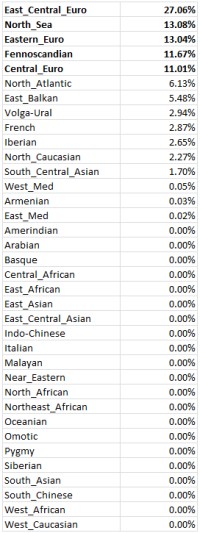Search This Blog
Saturday, March 9, 2013
Eurogenes K36 now at GEDmatch
I've just put together a new test for GEDmatch called the Eurogenes K36. Obviously, the K36 means that it features thirty six ancestral clusters. It probably won't include any Oracles, mostly because the Calculator Effect would render these useless if they were based on the average results of the reference samples, and it'd be very time consuming for me to test a wide variety of other samples in supervised mode using thirty six sets of allele frequencies.
The main purpose of the Eurogenes K36 is to help users unravel the ethnic origins of local areas of their genomes (aka. half-segments), hence the high number of ancestral categories, some of which are very specific. In other words, the test is mainly a chromosome painting utility. It's accessible via the GEDmatch Ad-Mix link below:
GEDmatch > Ad-Mix page > Eurogenes > Eurogenes K36
An important point to keep in mind is not to take the ancestry proportions too literally. If you're, say, English, and you get an Iberian score of 12% this doesn't actually mean you have recent ancestry from Spain or Portugal. What it means is that 12% of your alleles look typical of the reference samples classified as Iberian, and this figure might only indicate recent Iberian admixture if it's clearly higher than those of other English users.
Another way to look at it is that the ancestry proportions are like map coordinates, and they'll place you with a very high degree of accuracy on a genetic map featuring other users. Indeed, please feel free to post your scores and ancestry details in the comments below to help others get an idea of what their results might represent. My results are listed below. The scores put me squarely in Poland relative to those of other European samples I've run, which is correct.
Also worth mentioning is that this test focuses on much deeper ancestry than the Ancestry Composition at 23andMe. Hence, I expect that many Europeans will score a few percent in non-European clusters. However, like many ADMIXTURE results, this could give us strong hints about population movements into Europe during prehistory and early history, so it's worth keeping an eye on.
Subscribe to:
Posts (Atom)
